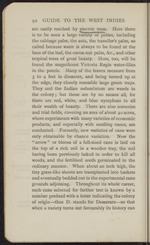| 1 |
 |
“...92 GUIDE TO THE WEST INDIES
are easily reached by electric tram. Here there
is to be seen a large variety of palms, including
the cabbage palm, the aeta, the traveller’s palm, so
called because water is always to be found at the
base of the leaf, the cocoa-nut palm, &c., and other
tropical trees of great beauty. Here, too, will be
found the magnificent Victoria Regia water-lilies
in the ponds. Many of the leaves measure from
3 to 4 feet in diameter, and being turned up at
the edge, they closely resemble large green trays.
They and the Indian nelumbrium are weeds in
the colony; but these are by no means all, for
there are red, white, and blue nympheas in all
their wealth of beauty. There are also nurseries
and trial fields, covering an area of about 40 acres,
where experiments with many varieties of economic
products, and especially with seedling canes, are
conducted. Formerly, new varieties of cane were
only obtainable by chance variation. Now the
“ arrow ” or bloom of a full-sized cane...”
|
|
| 2 |
 |
“...part the valley
opens out into a flat plain, which formerly used
to be under sugar canes, but is now for the most
part quite uncultivated. The plain has an evil
reputation, having been the scene of no less
than four blood-curdling murders, the last being
when a priest was brutally murdered and was
found tied to a tree. At the head of the valley
conveyances stop, and visitors proceed afoot up
a winding mountain path for about half a mile.
The Blue Basin is a small lake, forty or fifty yards
in diameter, into which a waterfall precipitates
itself in a slanting direction from the midst of
dense tropical foliage. Visitors can generally
depute a small boy to bathe in the azure waters, I
if one of the party does not care to do so himself, |
and thus form the foreground to a striking picture
for the camera.
To the Saddle (18 miles from Port of Spain), The Saddle,
a pass in the mountain range dividing the Maraval
and Santa Cruz valleys, is a splendid ride or
drive through some of the oldest and best...”
|
|
